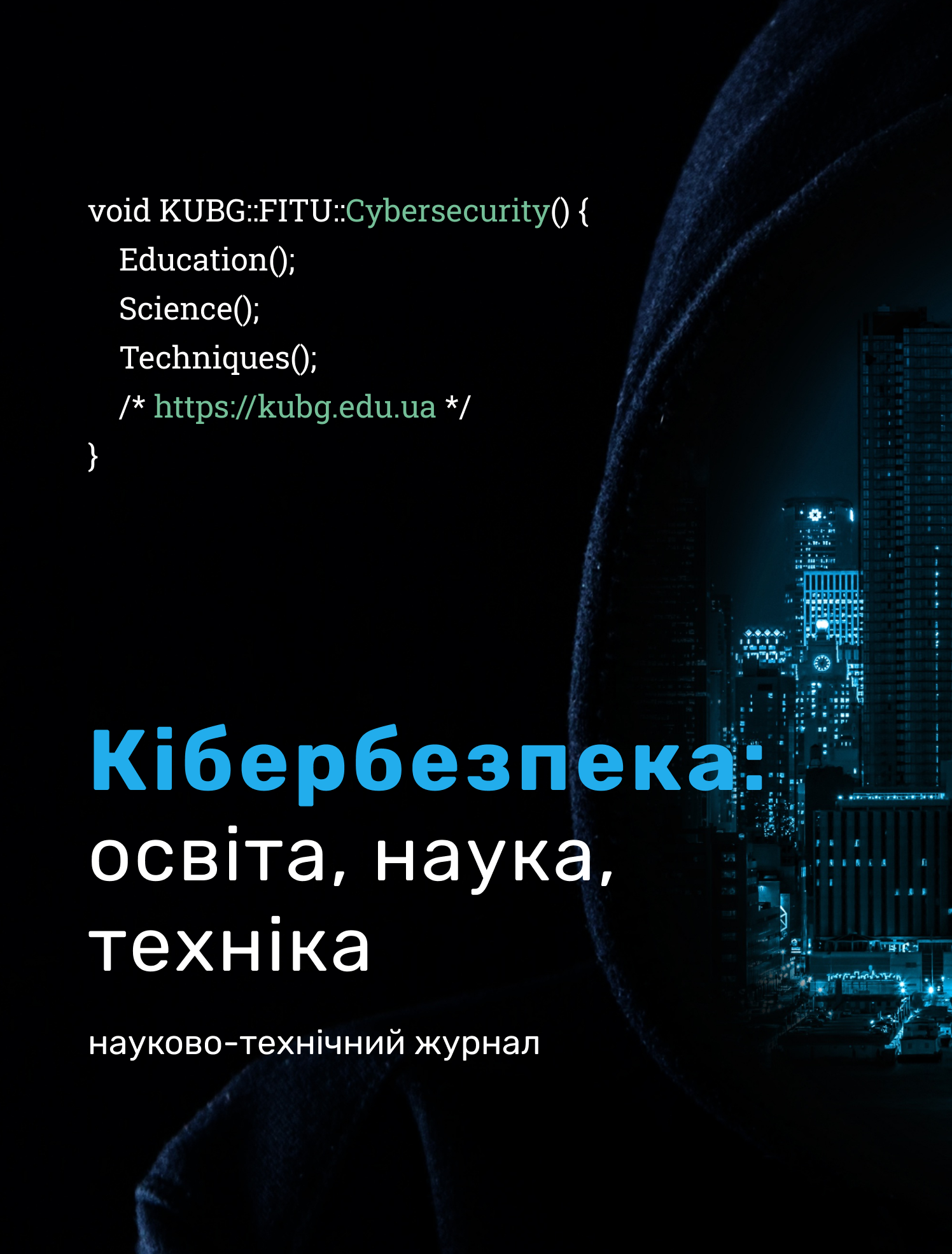SYNERGIC APPROACH BASED ASSESSMENT OF BUSINESS-PROCESSES CONTINUITY
DOI:
https://doi.org/10.28925/2663-4023.2023.21.162176Keywords:
cyberterrorism, cyberattack, critical infrastructure, business-processes continuityAbstract
Informational threats can manifest themselves in different forms, which is due to the features of the global network. The article is devoted to one of the ways of solving the contradiction, which is that, despite the large number of publications, the task of ensuring the continuity of business processes in the conditions of the growing number and variety of cyber attacks on critical infrastructure objects remains unresolved. This is due to the constant modification and increase in the number of cyber attacks, as well as methods and technologies for implementing business processes. Therefore, the development and improvement of methods for assessing the continuity of business processes is an urgent scientific task. The article examines the problem of ensuring the continuity of business processes in the conditions of the growth of cyber threats. The means and methods of committing cybercrimes against critical infrastructure facilities were analyzed. The main strategies and business continuity assessment indicators are defined. The influence of selected strategies and solutions for ensuring business continuity on the value of business process continuity indicators is analyzed. The main trends in the development of cyber security in the context of improving the means and methods of carrying out terrorist information attacks on critical infrastructures are analyzed. Preventive measures to reduce the risk of cyberattacks at the national and international levels have been identified.
The main tasks of ensuring the continuity of business processes based on the PDCA risk management model, indicators for assessing business continuity are considered. The influence of the selected strategies and solutions on ensuring the continuity of business processes is analyzed.
Downloads
References
Hryschuk, R.V., Danyk, Yu.G. (2016). Fundamentals of cyber security: Monograph. ZhNAEU.
Yevseiev, S., Ponomarenko, V., Laptiev, O., Milov, O., Korol, O., Milevskyi, S. et. al. (2021). Synergy of building cybersecurity systems. РС ТЕСHNOLOGY СЕNTЕR. http://doi.org/10.15587/978-617-7319-31-2
Sokol, Y., Trush, O., Yevseiev, S., & Milov, O. (2023). Implementation of Information and Communication Technologies in the Educational Process. У 2023 5th International Congress on Human-Computer Interaction, Optimization and Robotic Applications (HORA). IEEE. https://doi.org/10.1109/hora58378.2023.10156664.
Yevseiev, S., Hryshchuk, R., Molodetska, K., Nazarkevych, M., Hrytsyk, V., Milov, O. et. al. (2022). Modeling of security systems for critical infrastructure facilities. РС ТЕСHNOLOGY СЕNTЕR. http://doi.org/10.15587/978-617-7319-57-2
Milov, O., Yevseiev, S., Ivanchenko, Y., Milevskyi, S., Nesterov, O., Puchkov, O., Salii, A., Timochko, O., Tiurin, V., & Yarovyi А. (2019). Development of the model of the antagonistic agents behavior under a cyber conflict. Eastern-European Journal of Enterprise Technologies, 4(9 (100), 6–19. https://doi.org/10.15587/1729-4061.2019.175978
Milov, O., Voitko, A., Husarova, I., Domaskin, O., Ivanchenko, Y., Ivanchenko, I., Korol, O., Kots, H., Opirskyy, I., & Fraze-Frazenko, O. (2019). Development of methodology for modeling the interaction of antagonistic agents in cybersecurity systems. Eastern-European Journal of Enterprise Technologies, 2(9 (98), 56–66. https://doi.org/10.15587/1729-4061.2019.164730
Milov, O., Yevseiev, S., Vlasov, A., Herasimov, S., Dmitriiev, O., Kasianenko, M., Pievtsov, H., Peleshok, Y., Tkach, Y., & Faraon, S. (2019). Development of scenario modeling of conflict tools in a security system based on formal grammars. Eastern-European Journal of Enterprise Technologies, 6(9 (102), 53–64. https://doi.org/10.15587/1729-4061.2019.184274
Milov, O., Yevseiev, S., Aleksiyev, V., Berdnik, P., Voitko, O., Dyptan, V., Ivanchenko, Y., Pavlenko, M., Salii, A., & Yarovyy, S. (2019). Development of the interacting agents behavior scenario in the cyber security system. Eastern-European Journal of Enterprise Technologies, 5(9 (101), 46–57. https://doi.org/10.15587/1729-4061.2019.181047
Ivanchenko, E.V., Khoroshko, V.A. (2014). Trends in the development of cyberterrorism. In MNPK “Modern Information and Electronic Technologies” (p. 105 – 106).
Some aspects of cyberterrorism. http://nk.org.ua/geopolitika/nekotoryie-aspektyi-kiberterrorizma-16846.
Yevseiev, S., Ryabukha, Y. ., Milov, O., Milevskyi, S., Pohasii, S., Melenti, Y., Ivanchenko, Y., Ivanchenko, I., Opirskyy, I., & Pasko, I. (2021). Development of a method for assessing forecast of social impact in regional communities. Eastern-European Journal of Enterprise Technologies, 6(2 (114), 30–43. https://doi.org/10.15587/1729-4061.2021.249313
Zvertseva, N.V., Evseev, S.P., Rzaev, H.N., Mamedova, T.A., Samedov, F.G. (2018). Classifier of cyber threats of information resources of automated banking systems. Cyber security: education, science, technology, 2(2), 48-67.
Uniting and Strengthening America by Providing Appropriate Tools Required to Intercept and Obstruct Terrorism (USA PATRIOT) Act of 2001. H.R. 3162.
Leonenko, H., & Yudin, O. (2013). Problems of ensuring information security of ukraine critical information infrastructure systems. Collection "Information technology and security", 2(1), 44–48. https://doi.org/10.20535/2411-1031.2013.2.1.58384.
Yevseiev, S., Melenti, Y., Voitko, O., Hrebeniuk, V., Korchenko, A. ., Mykus, S., Milov, O. ., Prokopenko, O., Sievierinov О., & Chopenko, D. (2021). Development of a concept for building a critical infrastructure facilities security system. Eastern-European Journal of Enterprise Technologies, 3(9(111), 63–83. https://doi.org/10.15587/1729-4061.2021.233533
Yevseiev, S., Milov, O., Zviertseva, N., Lezik, O., Komisarenko, O., Nalyvaiko, A., Pogorelov, V., Katsalap, V., Pribyliev, Y., & Husarova, I. (2023). Development of the concept for determining the level of critical business processes security. Eastern-European Journal of Enterprise Technologies, 1(9 (121), 21–40. https://doi.org/10.15587/1729-4061.2023.274301
ISO/IEC 27031:2011 Information Technology – Security Techniques – Guidelines for Information and Communication Technology Readiness for Business Continuity. http://www.iso.org/iso/ru/home/store/catalogue_tc/catalogue_detail.htm?csnumber=44374.
ISO/IEC 27001:2013. Information technology – Security techniques – Information security management systems – Requirements. http://www.iso.org/iso/home/store/catalogue_tc/catalogue_detail.htm?csnumber=54534
Laptiev, O., Sobchuk, V., Subach, I., Barabash, A., Salanda, I. (2022). The Method of Detecting Radio Signals Using the Approximation of Spectral Function. In CEUR Workshop Proceedings, 3384, (p. 52–61). Scopus.
Sobchuk, V., Zelenska, I., Laptiev, O. (2023). Algorithm for solution of systems of singularly perturbed differential equations with a differential turning point. Bulletin of the Polish Academy of Sciences Technical Sciences, 71(3). https://doi.org/10.24425/bpasts.2023.145682
Laptiev, O., and al. (2023). Methodology for confirming the feasibility of exploiting detected vulnerabilities in a corporate network using polynomial transformations of bernstein. Challenges and threats to critical infrastructure. Collective monograph. NGO Institute for Cyberspace Research.
Published
How to Cite
Issue
Section
License
Copyright (c) 2023 Наталія Звєрцева

This work is licensed under a Creative Commons Attribution-NonCommercial-ShareAlike 4.0 International License.




